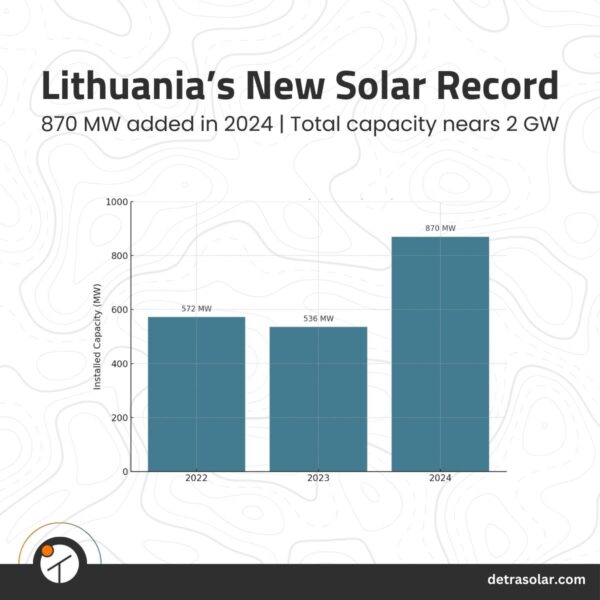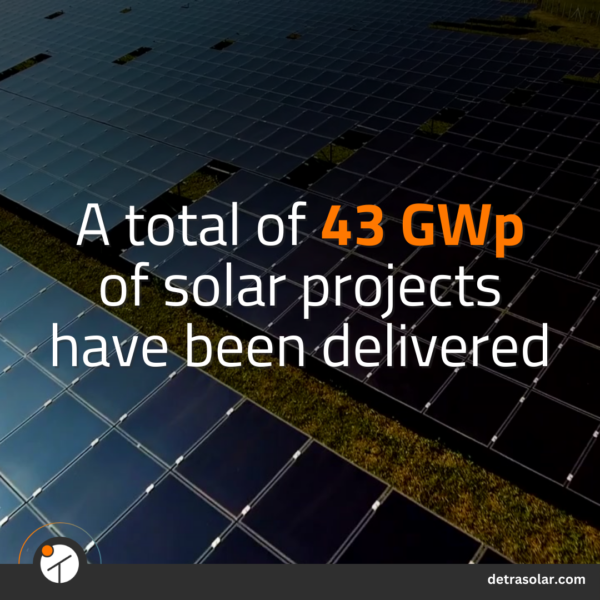Understanding Ground Covering Ratio (GCR) in Solar PV Systems

Detra Solar’s Design Engineer Mohammad Eneizat shares his insights into the Ground Covering Ratio calculations and practical implications.
Definition and Calculation of GCR
Ground Covering Ratio (GCR) is a crucial metric in optimizing solar photovoltaic (PV) systems. It measures the proportion of ground area covered by PV modules within an array. GCR is calculated by dividing the collector length perpendicular to the row length (L) by the row pitch (R), expressed mathematically as GCR = L / R. A GCR of 1 indicates complete coverage with no horizontal gaps between modules, while a GCR of 0 signifies minimal ground coverage with infinite inter-row spacing.
Impact on Shading and Energy Yield
GCR significantly influences shading losses and energy yield in PV arrays, especially in fixed-tilt configurations. As GCR increases, shading losses between adjacent rows also increase, reducing the amount of sunlight reaching the PV modules and thus diminishing energy yield. Conversely, a lower GCR may reduce shading losses but could lead to other issues such as cosine losses, which depend on the array configuration and environmental conditions.
Optimization for Different Configurations and Locations
The optimal GCR varies depending on the PV system configuration, geographical location, and environmental conditions. For fixed-tilt arrays, balancing shading losses with factors like tilt angle and latitude is essential to determine the optimal GCR. In regions with high solar elevation angles, lower GCR values may be preferable to minimize shading. Conversely, higher GCR values might be more suitable for areas with lower solar elevation angles. The optimal GCR also varies between monofacial and bifacial modules, with bifacial modules potentially benefiting from higher GCR values due to their ability to capture ground-reflected light.
Influence on Tilt Adjustment
GCR significantly impacts the optimal tilt adjustment of PV modules, particularly in fixed-tilt arrays. Increasing GCR generally lowers the optimal tilt angle to mitigate inter-row shading losses. On the other hand, decreasing GCR may necessitate adjusting the tilt angle to minimize other losses such as cosine losses. This interplay between GCR and tilt adjustment is a key consideration in PV system design and optimization.
Considerations for Bifacial Modules
The impact of GCR on energy yield differs between monofacial and bifacial PV modules. Bifacial modules, which can capture sunlight from both the front and rear sides, are less sensitive to shading losses. As a result, the optimal GCR for bifacial modules may be higher than for monofacial modules, potentially enhancing overall energy production by utilizing ground-reflected light.
Practical Implementation and Field Tolerances
In real-world PV system implementation, practical considerations and field tolerances play a critical role in determining the optimal GCR. Factors such as terrain topography, installation constraints, and maintenance requirements influence GCR selection. Additionally, variations in ground clearance between modules and potential environmental obstructions impact the effective GCR achieved in practice. Therefore, balancing theoretical optimization with practical feasibility is crucial when determining the GCR for a given PV installation.







